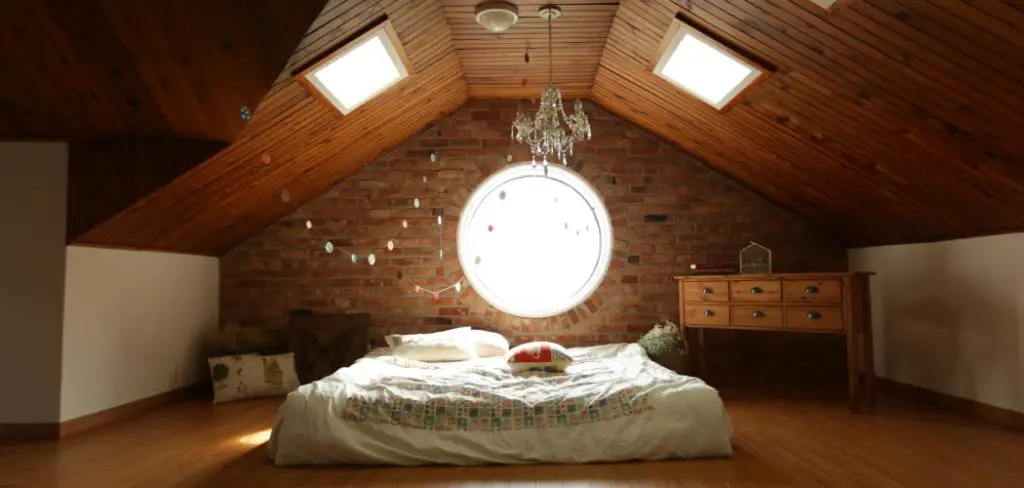Are you tired of feeling overheated in your attic room during summer? Do you want to find a way to keep your space cool without breaking the bank on expensive air conditioning units? Look no further – we have some tips and tricks for you on how to cool a attic room.
Cooling an attic room can be challenging due to its unique environment and exposure to the sun. Unlike other parts of the house, attic rooms often lack adequate insulation and ventilation, which results in overheating, especially during the warmer months. Successfully cooling an attic requires a combination of strategies that focus on improving air circulation, enhancing insulation, and effectively utilizing cooling devices.
With the right approach, you can transform a sweltering attic space into a comfortable and livable area throughout the year.

What Will You Need?
Before diving into the various methods for cooling an attic room, let’s first discuss the essential items you need to get started.
- Box fan or ceiling fan to improve air circulation
- Insulation materials such as foam board or spray foam
- Blackout curtains or window shades to block out sunlight
- A portable air conditioning unit or evaporative cooler (depending on your budget and specific needs)
- Essential tools like a drill, hammer, and screws for installation purposes
Once you have these items ready, it’s time to move on to the next step – identifying the root causes of heat in your attic room.
10 Easy Steps on How to Cool a Attic Room
Step 1. Identify Air Leaks:
The first crucial step in cooling an attic room is identifying and sealing air leaks. Air leaks are common in attic rooms, particularly around windows, doors, electrical outlets, and minor structural gaps. These leaks allow hot air from outside to infiltrate your space while letting cooled air escape, making it challenging to maintain a comfortable temperature.
To identify these leaks, thoroughly inspect your attic, checking for drafts or visible light coming through cracks and gaps. You can also perform a smoke test by holding a lit incense stick near suspected areas; any movement of the smoke will indicate a draft. Once you’ve identified the leaks, seal them using weatherstripping for windows and doors or applying caulk and expanding foam insulation to fill in cracks and gaps.

Step 2. Improve Insulation:
Once the air leaks are sealed, the next step is enhancing the insulation in your attic room. Proper insulation helps keep the space cool in the summer and retains warmth during the winter. Start by checking if the existing insulation is sufficient or needs enhancement. You can add extra layers of insulation using materials like fiberglass batts, foam boards, or spray foam. Focus on insulating the attic floor, walls, and ceiling to ensure comprehensive coverage. Consider installing radiant barriers that reflect heat away from the living space for additional effectiveness.
Step 3. Enhance Ventilation:
Enhancing ventilation is critical to maintaining a calm attic environment. Proper airflow prevents heat build-up and keeps the air circulating, reducing the overall temperature of the space. Start by checking if your attic has adequate ventilation systems such as ridge vents, soffit vents, or gable vents, which allow hot air to escape and cool air to enter. If these are absent or insufficient, consider installing additional vents or a powered attic fan to boost airflow. An attic fan can significantly decrease the temperature by drawing in cooler air from outside while expelling hot, stagnant air. Regular maintenance, such as cleaning vents and ensuring they are unobstructed, will also improve ventilation efficiency.
Step 4. Use Reflective Window Treatments:
Implementing reflective window treatments effectively keeps your attic room cool by minimizing solar heat gain. Blackout curtains or window shades with a reflective backing can significantly reduce the heat that enters through windows. During the hottest parts of the day, keep these curtains or shades drawn to block direct sunlight. Additionally, applying reflective window film directly onto the glass can help reflect a portion of the sun’s rays and reduce heat buildup. Combining these treatments with your existing cooling strategies will enhance the overall comfort of your attic space by helping maintain a lower indoor temperature.

Step 5. Install a Ceiling or Box Fan:
Installing a ceiling or box fan is an inexpensive yet effective method to increase airflow and cool your attic room. Fans can help evenly distribute cooler air and reduce the need for more energy-intensive devices when used in conjunction with other cooling strategies. If your attic room’s structure allows, a ceiling fan is the most efficient option as it provides consistent circulation from a central point. Position the fan to rotate counterclockwise during summer to produce a cooling breeze.
Alternatively, a box fan positioned in a window can be an excellent alternative for spaces where a ceiling fan installation may be impractical. To maximize its effectiveness, place the fan to pull cooler air inside from shaded areas outside or exhaust warm air from the attic. Additionally, portable pedestal fans can direct air to specific areas within the room, enhancing overall circulation. Incorporating fans provides immediate relief from the heat and complements other cooling efforts by keeping the air moving and preventing hot spots from developing.
Step 6. Opt for a Portable Air Conditioner or Evaporative Cooler:
Consider adding a portable air conditioner or an evaporative cooler to your attic room for an additional temperature control layer. A portable air conditioner is effective in dehumidifying and cooling the air, making it an excellent choice for scorching and humid climates. These units are easy to move and can be vented through a window or, with the proper adjustments, through a wall.
On the other hand, evaporative coolers, also known as swamp coolers, are more energy-efficient and environmentally friendly, especially in dry climates. They draw in warm air and pass it through water-saturated pads, resulting in cooler, moist air. When selecting your cooling unit, consider the size of your attic room and ensure it is appropriate for the BTU rating or output capacity needed for optimal performance.
Step 7. Incorporate Smart Home Technology:
Utilizing smart home technology can significantly enhance the efficiency and convenience of cooling your attic room. By installing a smart thermostat, you can program specific temperature schedules and remotely control the heating and cooling settings from your smartphone or other devices. This allows for greater precision in maintaining a comfortable environment while optimizing energy usage. Additionally, smart thermostats can provide energy usage reports and adapt to your patterns over time, further promoting efficiency. Consider integrating smart plugs or power strips for your fans and AC units, which can be scheduled or controlled remotely for enhanced operational control.

Step 8. Add Attic Insulation Panels to Windows:
Adding insulation panels to attic windows can provide an additional barrier against heat, enhancing your cooling efforts. Insulation panels, made from foam or reflective film, can be custom-cut to fit snugly into window frames, preventing air leaks and reducing heat transfer. This simple addition can help stabilize the attic room temperature during hot and cold months. Consider using removable panels to easily adjust as needed, allowing for increased insulation when the attic is most susceptible to temperature fluctuations.
Step 9. Utilize Light-Colored Roofing Materials:
Selecting light-colored roofing materials can play a pivotal role in controlling your attic’s temperature. Lighter shades reflect more sunlight than darker materials, helping to reduce heat absorption and, consequently, lower the overall temperature of the attic. If you’re building or renovating the attic, consider materials such as those in the “cool roof” range, specifically designed to reflect more sunlight and absorb less heat.
This can lead to a more comfortable indoor environment, reducing the reliance on mechanical cooling systems and promoting energy efficiency. Reflective roof coatings or tiles can be added for existing attics to enhance reflectivity without a complete roof replacement. Incorporating light-colored or reflective materials will not only contribute to a cooler attic but also extend the lifespan of the roofing by reducing thermal stress.

Step 10. Use Ventilation to Improve Air Circulation:
Proper ventilation is crucial in maintaining a comfortable temperature in your attic room. An effective way to improve air circulation is by installing ridge vents along the peak of the roof or soffit vents at the lower part of the eaves. These will work by allowing hot air to escape and cooler air to enter, creating a continuous airflow cycle that helps to regulate the attic’s temperature.
Additionally, consider actively using an attic fan powered by electricity or solar energy to remove hot air from the attic. Proper ventilation helps in cooling the attic and preventing moisture buildup, which can lead to mold and mildew problems. Integrating an efficient ventilation system ensures a balanced and more energy-efficient approach to maintaining a comfortable attic environment.
By following these steps, you can effectively cool your attic room and create a comfortable and energy-efficient living space.
Conclusion
How to cool a attic room involves a multifaceted approach that integrates both modern technology and practical, cost-effective methods.
You can create a comfortable living space that remains temperate throughout the year by employing a combination of insulation, strategic fan placement, portable cooling units, and innovative smart home technology. Additionally, enhancing window insulation, utilizing light-colored roofing materials, and ensuring sufficient ventilation will improve temperature regulation and contribute to your attic’s energy efficiency and environmental performance.
By taking these comprehensive steps, you can transform your attic into a cozy retreat that remains inviting regardless of the weather conditions outside.
About
Angela is the chief editor of Indoorense. She began her career as an interior designer before applying her strategic and creative passion to lifestyle and home.
She has close to 15 years of experience in creative writing and online content strategy for housekeeping and cleaning,home decorations as well as other efforts.
She loves her job and has the privilege of working with an extraordinary team. She lives with her husband, two sons, and daughter in Petersburg. When she’s not busy working she spent time with her family.

